Design Thinking and Innovation
VerifiedAdded on 2020/03/16
|12
|3424
|472
AI Summary
This assignment delves into the concept of design thinking and its role in driving innovation within organizations. Students are tasked with analyzing case studies of Renault and Volvo Cars, examining how these companies have implemented design thinking to enhance their product development processes and overall innovation strategies. The assignment requires a critical evaluation of design thinking's effectiveness in fostering groundbreaking solutions within the automotive industry.
Contribute Materials
Your contribution can guide someone’s learning journey. Share your
documents today.

Running head: REFLECTIVE REPORT
Reflective Report
Name of the Student
Name of the University
Author note
Reflective Report
Name of the Student
Name of the University
Author note
Secure Best Marks with AI Grader
Need help grading? Try our AI Grader for instant feedback on your assignments.
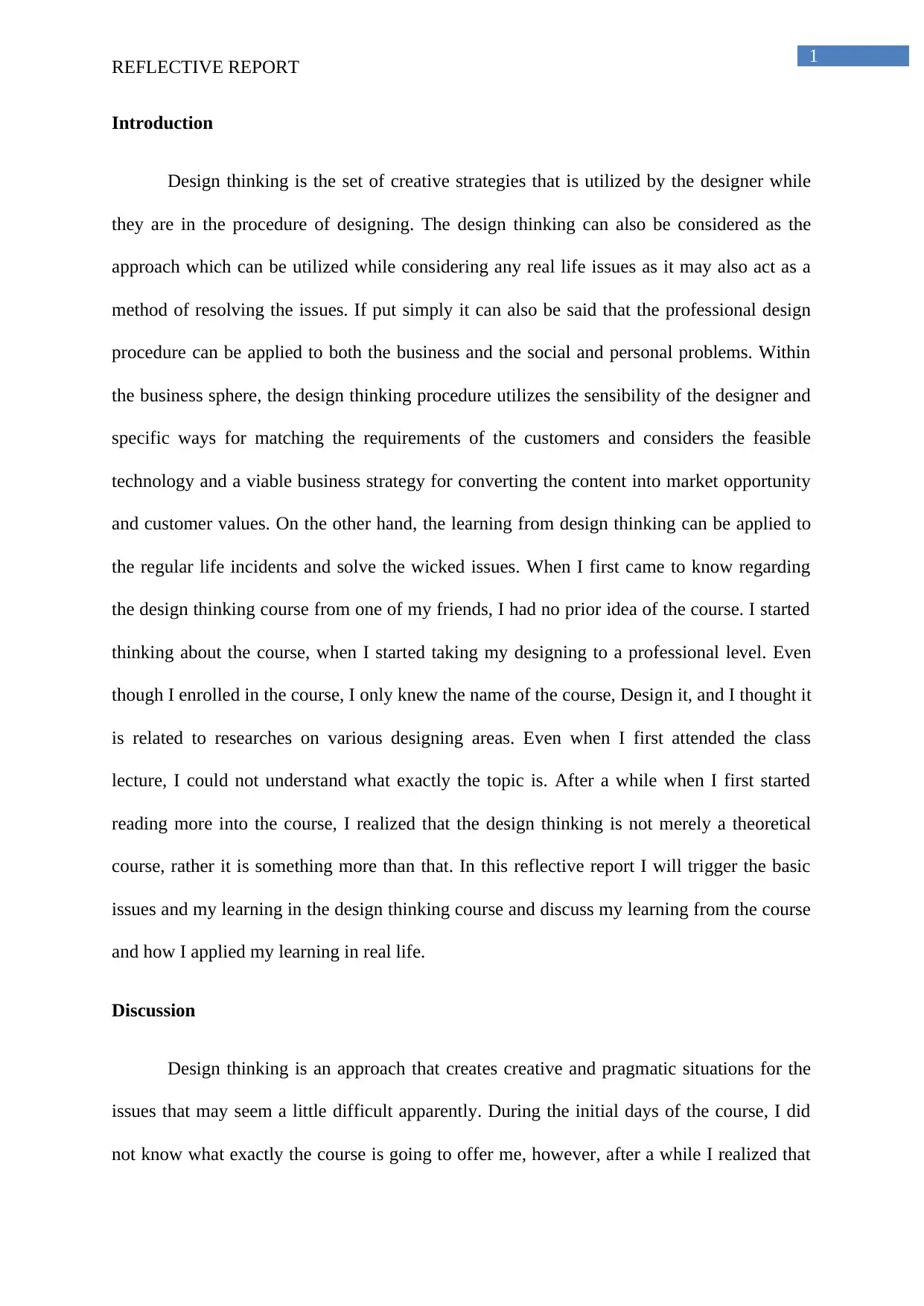
1
REFLECTIVE REPORT
Introduction
Design thinking is the set of creative strategies that is utilized by the designer while
they are in the procedure of designing. The design thinking can also be considered as the
approach which can be utilized while considering any real life issues as it may also act as a
method of resolving the issues. If put simply it can also be said that the professional design
procedure can be applied to both the business and the social and personal problems. Within
the business sphere, the design thinking procedure utilizes the sensibility of the designer and
specific ways for matching the requirements of the customers and considers the feasible
technology and a viable business strategy for converting the content into market opportunity
and customer values. On the other hand, the learning from design thinking can be applied to
the regular life incidents and solve the wicked issues. When I first came to know regarding
the design thinking course from one of my friends, I had no prior idea of the course. I started
thinking about the course, when I started taking my designing to a professional level. Even
though I enrolled in the course, I only knew the name of the course, Design it, and I thought it
is related to researches on various designing areas. Even when I first attended the class
lecture, I could not understand what exactly the topic is. After a while when I first started
reading more into the course, I realized that the design thinking is not merely a theoretical
course, rather it is something more than that. In this reflective report I will trigger the basic
issues and my learning in the design thinking course and discuss my learning from the course
and how I applied my learning in real life.
Discussion
Design thinking is an approach that creates creative and pragmatic situations for the
issues that may seem a little difficult apparently. During the initial days of the course, I did
not know what exactly the course is going to offer me, however, after a while I realized that
REFLECTIVE REPORT
Introduction
Design thinking is the set of creative strategies that is utilized by the designer while
they are in the procedure of designing. The design thinking can also be considered as the
approach which can be utilized while considering any real life issues as it may also act as a
method of resolving the issues. If put simply it can also be said that the professional design
procedure can be applied to both the business and the social and personal problems. Within
the business sphere, the design thinking procedure utilizes the sensibility of the designer and
specific ways for matching the requirements of the customers and considers the feasible
technology and a viable business strategy for converting the content into market opportunity
and customer values. On the other hand, the learning from design thinking can be applied to
the regular life incidents and solve the wicked issues. When I first came to know regarding
the design thinking course from one of my friends, I had no prior idea of the course. I started
thinking about the course, when I started taking my designing to a professional level. Even
though I enrolled in the course, I only knew the name of the course, Design it, and I thought it
is related to researches on various designing areas. Even when I first attended the class
lecture, I could not understand what exactly the topic is. After a while when I first started
reading more into the course, I realized that the design thinking is not merely a theoretical
course, rather it is something more than that. In this reflective report I will trigger the basic
issues and my learning in the design thinking course and discuss my learning from the course
and how I applied my learning in real life.
Discussion
Design thinking is an approach that creates creative and pragmatic situations for the
issues that may seem a little difficult apparently. During the initial days of the course, I did
not know what exactly the course is going to offer me, however, after a while I realized that

2
REFLECTIVE REPORT
this course can change my thought process and my attitude, not only to the business
processes, but also to daily life. In additional to that, the course work has also taught me
about the tools of design thinking which focuses more on the solving of the problem than just
finding it. The primary tools of design thinking are also associated with the concepts of
patterns and design, cognition and meta-cognition processes. All these processes are
interrelated and mutually complementary.
Design Thinking Procedure
Design thinking can be considered as a practical method which is helpful for
providing creative and practical solutions to the problems. It is mostly a kind of solution
based thinking which intends to produce the constructive result in future. As stated by (),
design thinking is a little different from the scientific methods. Considering the scientific
methods, those are mostly related to the hypothesis stating and providing a feedback
mechanism which later continues to form a theory or a model. However, on the other hand,
design thinking approach can offer the designers to include the contemplation of the primary
emotional content of the entire situation. In the scientific methods, the feedback of any event
or decision is obtained through the collection of the observational evidences which is also
related to the measurable and observable facts, however design thinking tends to consider the
feedback after considering the emotional state of the customers about the particular problem
and their latent and stated requirements while developing the solution for any particular
problem. The process of design thinking can also be considered as the way of producing
iterative solutions for the social and business issues, especially solutions from the alternative
areas. Design thinking tends to recognize and evaluate both the well-known and ambiguous
aspects of the existing situation and provides a serious effort for discovering the distinct
parameters and a set of alternative solutions that has the possibility of leading to the one or
multiple satisfactory objectives and goals. Design thinking also provides alternative solutions
REFLECTIVE REPORT
this course can change my thought process and my attitude, not only to the business
processes, but also to daily life. In additional to that, the course work has also taught me
about the tools of design thinking which focuses more on the solving of the problem than just
finding it. The primary tools of design thinking are also associated with the concepts of
patterns and design, cognition and meta-cognition processes. All these processes are
interrelated and mutually complementary.
Design Thinking Procedure
Design thinking can be considered as a practical method which is helpful for
providing creative and practical solutions to the problems. It is mostly a kind of solution
based thinking which intends to produce the constructive result in future. As stated by (),
design thinking is a little different from the scientific methods. Considering the scientific
methods, those are mostly related to the hypothesis stating and providing a feedback
mechanism which later continues to form a theory or a model. However, on the other hand,
design thinking approach can offer the designers to include the contemplation of the primary
emotional content of the entire situation. In the scientific methods, the feedback of any event
or decision is obtained through the collection of the observational evidences which is also
related to the measurable and observable facts, however design thinking tends to consider the
feedback after considering the emotional state of the customers about the particular problem
and their latent and stated requirements while developing the solution for any particular
problem. The process of design thinking can also be considered as the way of producing
iterative solutions for the social and business issues, especially solutions from the alternative
areas. Design thinking tends to recognize and evaluate both the well-known and ambiguous
aspects of the existing situation and provides a serious effort for discovering the distinct
parameters and a set of alternative solutions that has the possibility of leading to the one or
multiple satisfactory objectives and goals. Design thinking also provides alternative solutions
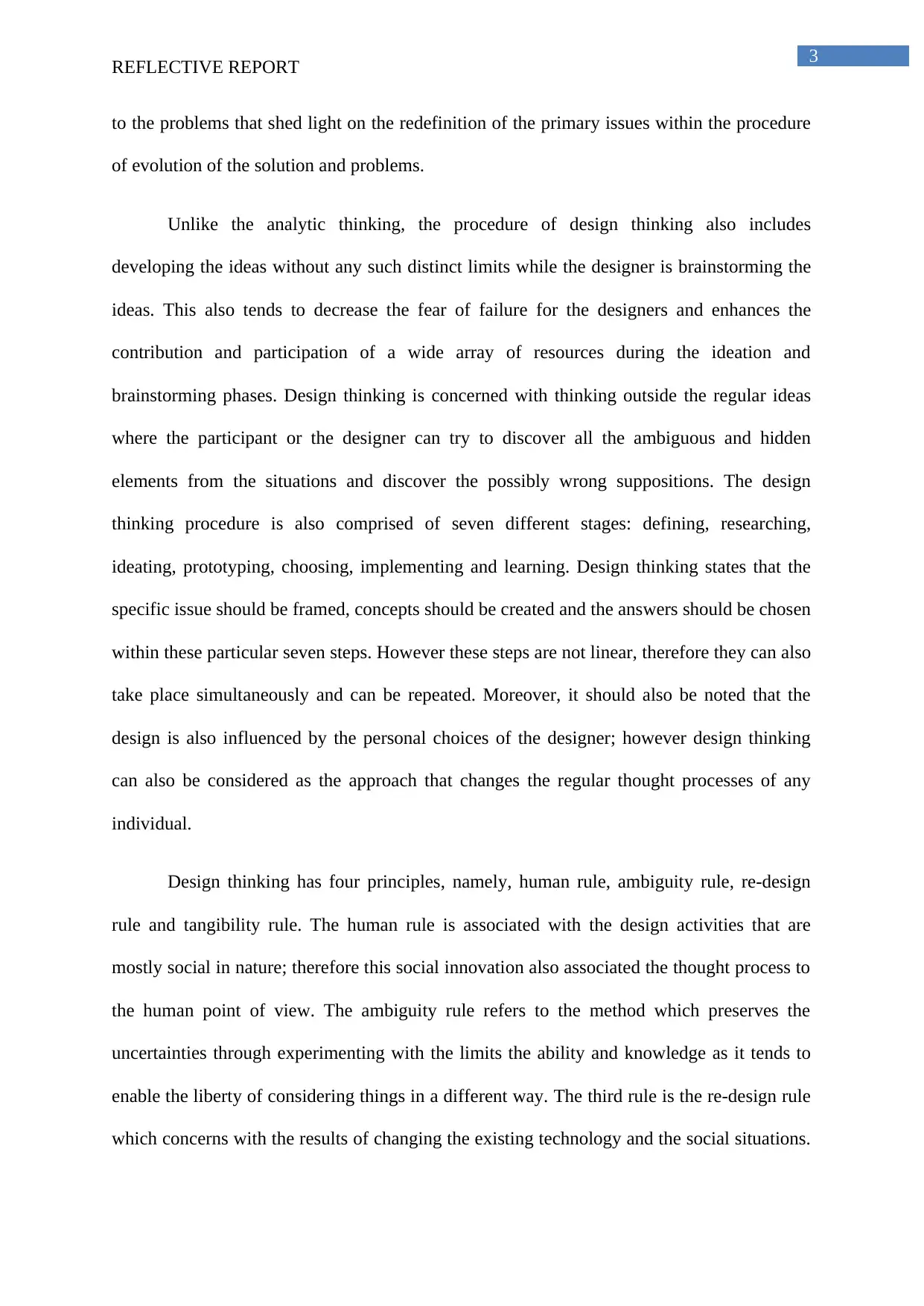
3
REFLECTIVE REPORT
to the problems that shed light on the redefinition of the primary issues within the procedure
of evolution of the solution and problems.
Unlike the analytic thinking, the procedure of design thinking also includes
developing the ideas without any such distinct limits while the designer is brainstorming the
ideas. This also tends to decrease the fear of failure for the designers and enhances the
contribution and participation of a wide array of resources during the ideation and
brainstorming phases. Design thinking is concerned with thinking outside the regular ideas
where the participant or the designer can try to discover all the ambiguous and hidden
elements from the situations and discover the possibly wrong suppositions. The design
thinking procedure is also comprised of seven different stages: defining, researching,
ideating, prototyping, choosing, implementing and learning. Design thinking states that the
specific issue should be framed, concepts should be created and the answers should be chosen
within these particular seven steps. However these steps are not linear, therefore they can also
take place simultaneously and can be repeated. Moreover, it should also be noted that the
design is also influenced by the personal choices of the designer; however design thinking
can also be considered as the approach that changes the regular thought processes of any
individual.
Design thinking has four principles, namely, human rule, ambiguity rule, re-design
rule and tangibility rule. The human rule is associated with the design activities that are
mostly social in nature; therefore this social innovation also associated the thought process to
the human point of view. The ambiguity rule refers to the method which preserves the
uncertainties through experimenting with the limits the ability and knowledge as it tends to
enable the liberty of considering things in a different way. The third rule is the re-design rule
which concerns with the results of changing the existing technology and the social situations.
REFLECTIVE REPORT
to the problems that shed light on the redefinition of the primary issues within the procedure
of evolution of the solution and problems.
Unlike the analytic thinking, the procedure of design thinking also includes
developing the ideas without any such distinct limits while the designer is brainstorming the
ideas. This also tends to decrease the fear of failure for the designers and enhances the
contribution and participation of a wide array of resources during the ideation and
brainstorming phases. Design thinking is concerned with thinking outside the regular ideas
where the participant or the designer can try to discover all the ambiguous and hidden
elements from the situations and discover the possibly wrong suppositions. The design
thinking procedure is also comprised of seven different stages: defining, researching,
ideating, prototyping, choosing, implementing and learning. Design thinking states that the
specific issue should be framed, concepts should be created and the answers should be chosen
within these particular seven steps. However these steps are not linear, therefore they can also
take place simultaneously and can be repeated. Moreover, it should also be noted that the
design is also influenced by the personal choices of the designer; however design thinking
can also be considered as the approach that changes the regular thought processes of any
individual.
Design thinking has four principles, namely, human rule, ambiguity rule, re-design
rule and tangibility rule. The human rule is associated with the design activities that are
mostly social in nature; therefore this social innovation also associated the thought process to
the human point of view. The ambiguity rule refers to the method which preserves the
uncertainties through experimenting with the limits the ability and knowledge as it tends to
enable the liberty of considering things in a different way. The third rule is the re-design rule
which concerns with the results of changing the existing technology and the social situations.
Secure Best Marks with AI Grader
Need help grading? Try our AI Grader for instant feedback on your assignments.

4
REFLECTIVE REPORT
In addition to that the tangibility rule refers to the idea that the ideas can be made tangible
and it allows the designers in treating people as prototypes.
Therefore, it can be understood that design thinking can be both implemented in the
designing procedure and in our day to day lives. The learning from the design thinking
approach can be applied in the regular chorus. It also offers a thinking approach which is
pragmatic and a little different from the conventional way of thinking.
Learning from the Design Thinking Course
When I first joined the course and started the class, initially I had no idea what I am
going to learn or what the course is going to offer me. With my previous working experiences
in the designing field, I had realized that the landscape is changing in a fast way within the
contemporary business world, therefore the employers and the marketers tend to fix a specific
set of expertise and skills so that they can position their brand and gain a competitive edge in
the market. Moreover, the increasing capability of information also concerned with the
empowerment of the consumers, therefore there are higher possibilities that the flexibility and
agility are required for this purpose.
Design thinking is a concept that is associated with the design revolution. The
business landscape of today’s world demands the brands and marketers to be more centered
on the customers. Therefore design thinking is mostly creates a beneficial relationship
between the consumers and brands. The brands tend to focus more on the requirements of the
customers. Moreover design thinking is considered as the idea that is a driver of revolution of
the designing genre. I had some previous experiences in the designing field. Initially I did not
think to take this up as my career, however later when I started thinking about thinking
designing as my professional career, I realized that not having professional course has made
my career limited and most importantly amateurish. Therefore this course could have made
REFLECTIVE REPORT
In addition to that the tangibility rule refers to the idea that the ideas can be made tangible
and it allows the designers in treating people as prototypes.
Therefore, it can be understood that design thinking can be both implemented in the
designing procedure and in our day to day lives. The learning from the design thinking
approach can be applied in the regular chorus. It also offers a thinking approach which is
pragmatic and a little different from the conventional way of thinking.
Learning from the Design Thinking Course
When I first joined the course and started the class, initially I had no idea what I am
going to learn or what the course is going to offer me. With my previous working experiences
in the designing field, I had realized that the landscape is changing in a fast way within the
contemporary business world, therefore the employers and the marketers tend to fix a specific
set of expertise and skills so that they can position their brand and gain a competitive edge in
the market. Moreover, the increasing capability of information also concerned with the
empowerment of the consumers, therefore there are higher possibilities that the flexibility and
agility are required for this purpose.
Design thinking is a concept that is associated with the design revolution. The
business landscape of today’s world demands the brands and marketers to be more centered
on the customers. Therefore design thinking is mostly creates a beneficial relationship
between the consumers and brands. The brands tend to focus more on the requirements of the
customers. Moreover design thinking is considered as the idea that is a driver of revolution of
the designing genre. I had some previous experiences in the designing field. Initially I did not
think to take this up as my career, however later when I started thinking about thinking
designing as my professional career, I realized that not having professional course has made
my career limited and most importantly amateurish. Therefore this course could have made

5
REFLECTIVE REPORT
my resume more interesting to the employers. Creating and designing have been my passion
for a long time, however taking those up as a career made me realize the importance of
having professional degree in the designing field. However, the course not only offered me a
quality designing power which is not only limited to the creation of specific objects, but it is
also refers to the ‘out of the box’ thinking of the content. Along with the course, I have
realized that the concept of design thinking stands completely different way for developing
successful strategy and further organizational change. The concept is also related with the
managing, leading, innovating and creating the content because everything can be someway
designed. Moreover, I had also learnt a major lesson that design is not only related to the
looks. Conventionally it has been related and specifically restricted to the appearances;
however, it is not actually that at all. It is somewhat related to crafting something entirely
new after shelling out of the traditional and conventional ways. As a matter of fact, design
thinking is something that is out of the basic dimensions of individual intelligence. Design
thinking has taught me to break the conventional and shallow mentality that we tend to carry
and begin inculcating a different outlook that always encourages more innovation. It has also
taught me regarding a systematic framework that enhances the implementation of innovation
by fostering the organic development ad serve value for the clients. Previously I had thought
that creativity should be the primary necessity for the designs, however design thinking has
also taught me that the stages in design thinking also includes a sheer observation for learning
the other requirements of the customers relating to the constraints and context of any
situation. Design thinking also made me learn and discover the capacity and opportunity of
bringing innovation and forming creative ideas, testing them and improving further.
Design thinking also refers to the innovation that is customer centric through the
profound knowledge that is mostly based on the users or the customers through a series of
different prototypes for finding, testing and improving the basic concepts. As a design
REFLECTIVE REPORT
my resume more interesting to the employers. Creating and designing have been my passion
for a long time, however taking those up as a career made me realize the importance of
having professional degree in the designing field. However, the course not only offered me a
quality designing power which is not only limited to the creation of specific objects, but it is
also refers to the ‘out of the box’ thinking of the content. Along with the course, I have
realized that the concept of design thinking stands completely different way for developing
successful strategy and further organizational change. The concept is also related with the
managing, leading, innovating and creating the content because everything can be someway
designed. Moreover, I had also learnt a major lesson that design is not only related to the
looks. Conventionally it has been related and specifically restricted to the appearances;
however, it is not actually that at all. It is somewhat related to crafting something entirely
new after shelling out of the traditional and conventional ways. As a matter of fact, design
thinking is something that is out of the basic dimensions of individual intelligence. Design
thinking has taught me to break the conventional and shallow mentality that we tend to carry
and begin inculcating a different outlook that always encourages more innovation. It has also
taught me regarding a systematic framework that enhances the implementation of innovation
by fostering the organic development ad serve value for the clients. Previously I had thought
that creativity should be the primary necessity for the designs, however design thinking has
also taught me that the stages in design thinking also includes a sheer observation for learning
the other requirements of the customers relating to the constraints and context of any
situation. Design thinking also made me learn and discover the capacity and opportunity of
bringing innovation and forming creative ideas, testing them and improving further.
Design thinking also refers to the innovation that is customer centric through the
profound knowledge that is mostly based on the users or the customers through a series of
different prototypes for finding, testing and improving the basic concepts. As a design
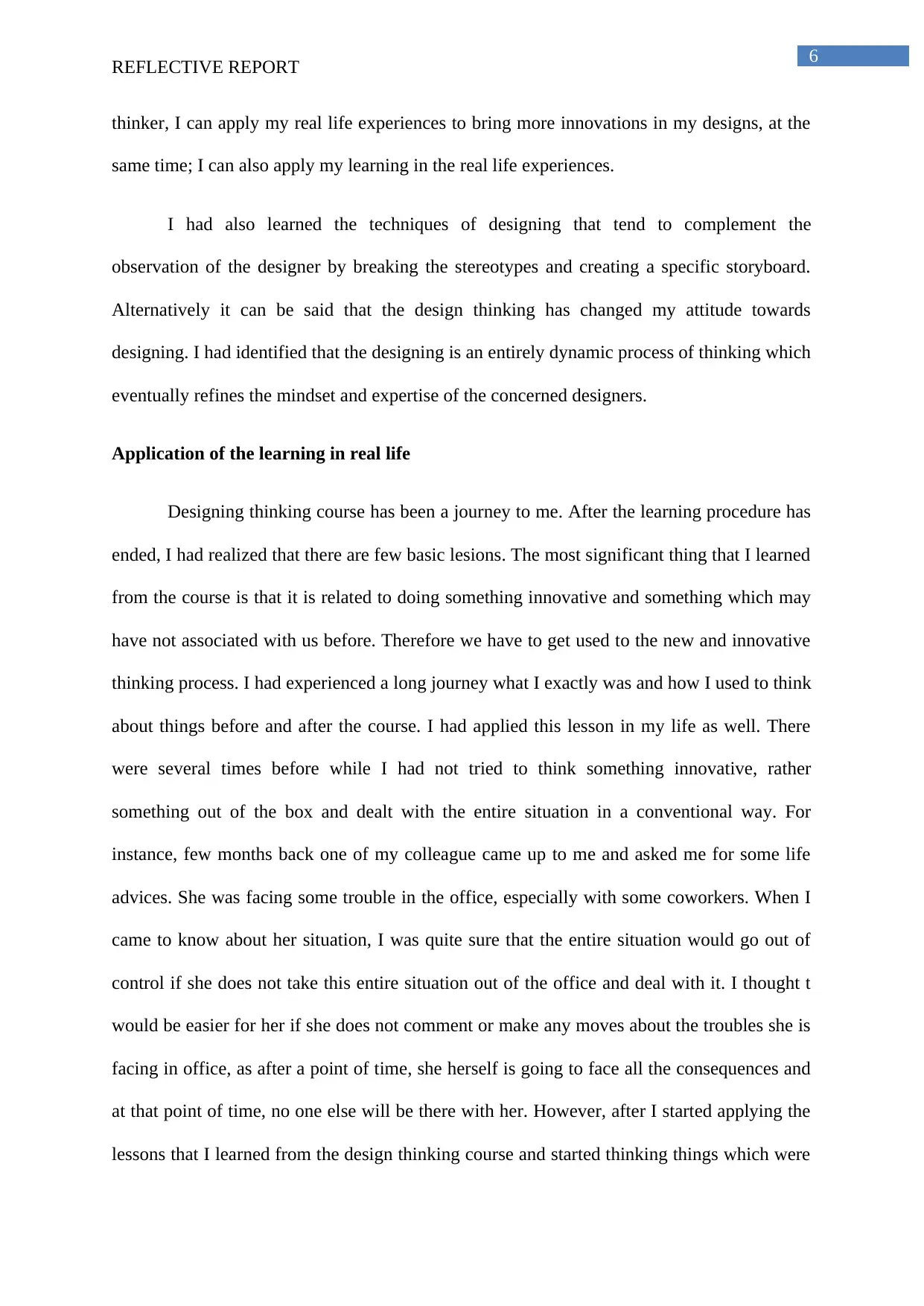
6
REFLECTIVE REPORT
thinker, I can apply my real life experiences to bring more innovations in my designs, at the
same time; I can also apply my learning in the real life experiences.
I had also learned the techniques of designing that tend to complement the
observation of the designer by breaking the stereotypes and creating a specific storyboard.
Alternatively it can be said that the design thinking has changed my attitude towards
designing. I had identified that the designing is an entirely dynamic process of thinking which
eventually refines the mindset and expertise of the concerned designers.
Application of the learning in real life
Designing thinking course has been a journey to me. After the learning procedure has
ended, I had realized that there are few basic lesions. The most significant thing that I learned
from the course is that it is related to doing something innovative and something which may
have not associated with us before. Therefore we have to get used to the new and innovative
thinking process. I had experienced a long journey what I exactly was and how I used to think
about things before and after the course. I had applied this lesson in my life as well. There
were several times before while I had not tried to think something innovative, rather
something out of the box and dealt with the entire situation in a conventional way. For
instance, few months back one of my colleague came up to me and asked me for some life
advices. She was facing some trouble in the office, especially with some coworkers. When I
came to know about her situation, I was quite sure that the entire situation would go out of
control if she does not take this entire situation out of the office and deal with it. I thought t
would be easier for her if she does not comment or make any moves about the troubles she is
facing in office, as after a point of time, she herself is going to face all the consequences and
at that point of time, no one else will be there with her. However, after I started applying the
lessons that I learned from the design thinking course and started thinking things which were
REFLECTIVE REPORT
thinker, I can apply my real life experiences to bring more innovations in my designs, at the
same time; I can also apply my learning in the real life experiences.
I had also learned the techniques of designing that tend to complement the
observation of the designer by breaking the stereotypes and creating a specific storyboard.
Alternatively it can be said that the design thinking has changed my attitude towards
designing. I had identified that the designing is an entirely dynamic process of thinking which
eventually refines the mindset and expertise of the concerned designers.
Application of the learning in real life
Designing thinking course has been a journey to me. After the learning procedure has
ended, I had realized that there are few basic lesions. The most significant thing that I learned
from the course is that it is related to doing something innovative and something which may
have not associated with us before. Therefore we have to get used to the new and innovative
thinking process. I had experienced a long journey what I exactly was and how I used to think
about things before and after the course. I had applied this lesson in my life as well. There
were several times before while I had not tried to think something innovative, rather
something out of the box and dealt with the entire situation in a conventional way. For
instance, few months back one of my colleague came up to me and asked me for some life
advices. She was facing some trouble in the office, especially with some coworkers. When I
came to know about her situation, I was quite sure that the entire situation would go out of
control if she does not take this entire situation out of the office and deal with it. I thought t
would be easier for her if she does not comment or make any moves about the troubles she is
facing in office, as after a point of time, she herself is going to face all the consequences and
at that point of time, no one else will be there with her. However, after I started applying the
lessons that I learned from the design thinking course and started thinking things which were
Paraphrase This Document
Need a fresh take? Get an instant paraphrase of this document with our AI Paraphraser
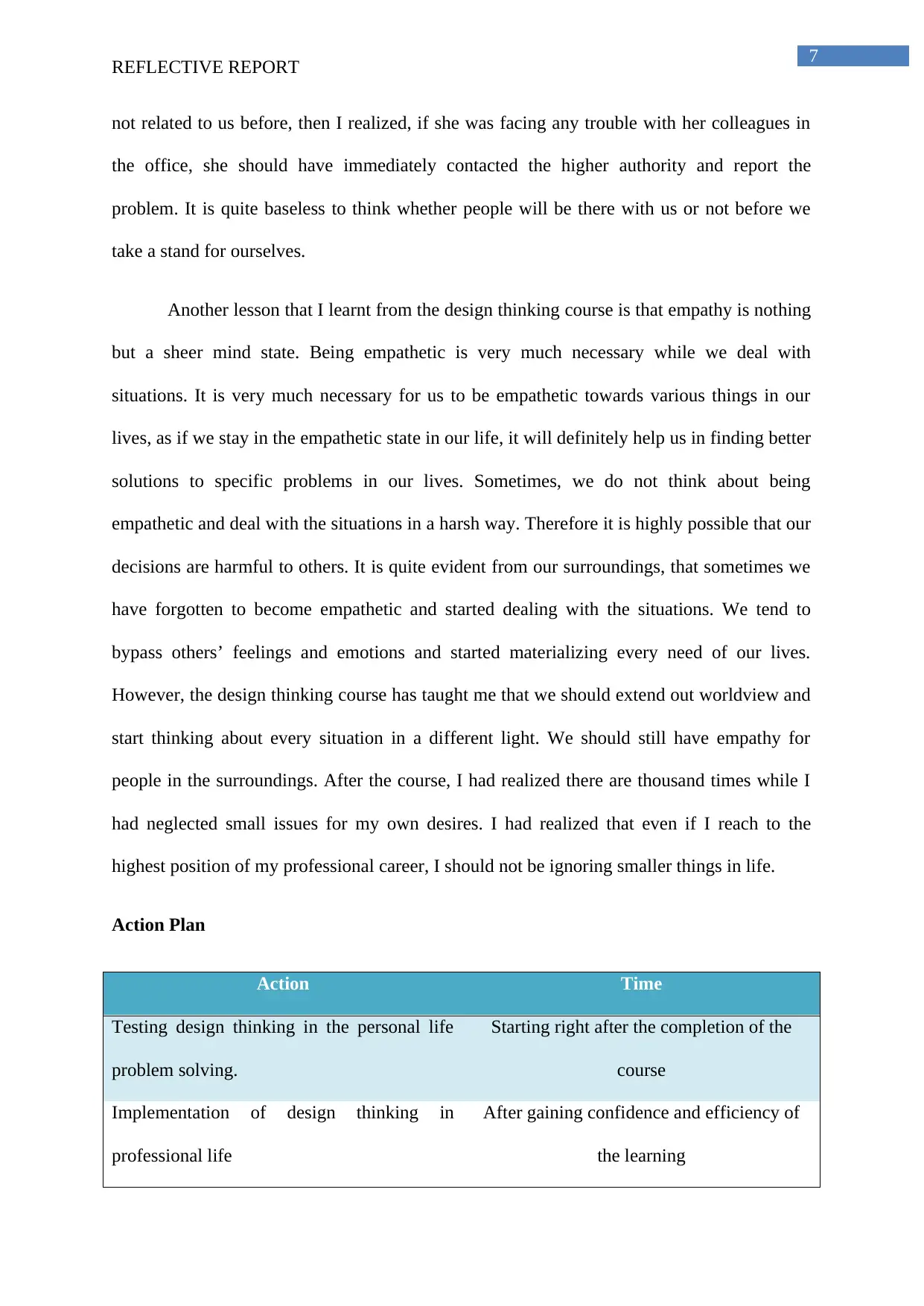
7
REFLECTIVE REPORT
not related to us before, then I realized, if she was facing any trouble with her colleagues in
the office, she should have immediately contacted the higher authority and report the
problem. It is quite baseless to think whether people will be there with us or not before we
take a stand for ourselves.
Another lesson that I learnt from the design thinking course is that empathy is nothing
but a sheer mind state. Being empathetic is very much necessary while we deal with
situations. It is very much necessary for us to be empathetic towards various things in our
lives, as if we stay in the empathetic state in our life, it will definitely help us in finding better
solutions to specific problems in our lives. Sometimes, we do not think about being
empathetic and deal with the situations in a harsh way. Therefore it is highly possible that our
decisions are harmful to others. It is quite evident from our surroundings, that sometimes we
have forgotten to become empathetic and started dealing with the situations. We tend to
bypass others’ feelings and emotions and started materializing every need of our lives.
However, the design thinking course has taught me that we should extend out worldview and
start thinking about every situation in a different light. We should still have empathy for
people in the surroundings. After the course, I had realized there are thousand times while I
had neglected small issues for my own desires. I had realized that even if I reach to the
highest position of my professional career, I should not be ignoring smaller things in life.
Action Plan
Action Time
Testing design thinking in the personal life
problem solving.
Starting right after the completion of the
course
Implementation of design thinking in
professional life
After gaining confidence and efficiency of
the learning
REFLECTIVE REPORT
not related to us before, then I realized, if she was facing any trouble with her colleagues in
the office, she should have immediately contacted the higher authority and report the
problem. It is quite baseless to think whether people will be there with us or not before we
take a stand for ourselves.
Another lesson that I learnt from the design thinking course is that empathy is nothing
but a sheer mind state. Being empathetic is very much necessary while we deal with
situations. It is very much necessary for us to be empathetic towards various things in our
lives, as if we stay in the empathetic state in our life, it will definitely help us in finding better
solutions to specific problems in our lives. Sometimes, we do not think about being
empathetic and deal with the situations in a harsh way. Therefore it is highly possible that our
decisions are harmful to others. It is quite evident from our surroundings, that sometimes we
have forgotten to become empathetic and started dealing with the situations. We tend to
bypass others’ feelings and emotions and started materializing every need of our lives.
However, the design thinking course has taught me that we should extend out worldview and
start thinking about every situation in a different light. We should still have empathy for
people in the surroundings. After the course, I had realized there are thousand times while I
had neglected small issues for my own desires. I had realized that even if I reach to the
highest position of my professional career, I should not be ignoring smaller things in life.
Action Plan
Action Time
Testing design thinking in the personal life
problem solving.
Starting right after the completion of the
course
Implementation of design thinking in
professional life
After gaining confidence and efficiency of
the learning
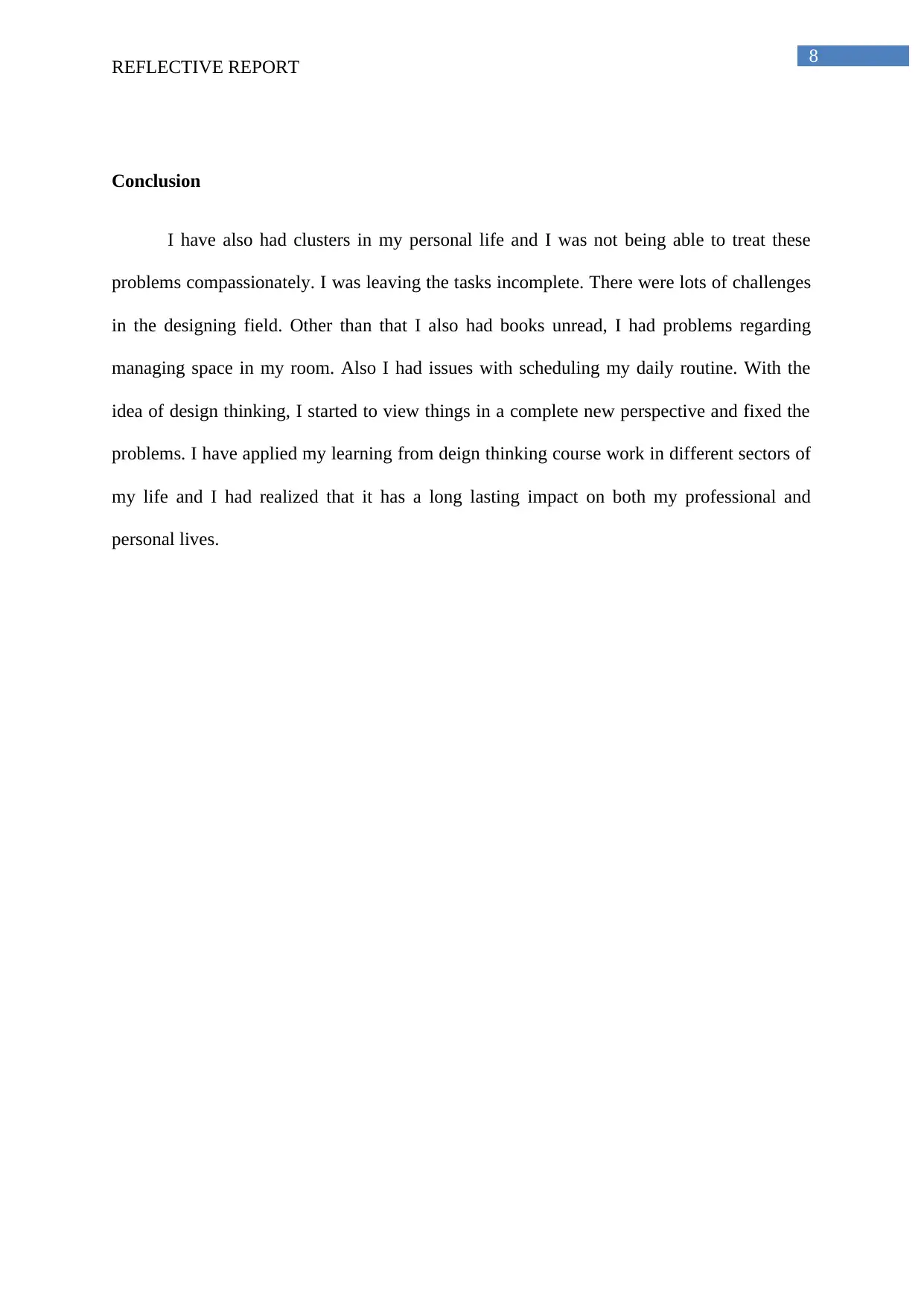
8
REFLECTIVE REPORT
Conclusion
I have also had clusters in my personal life and I was not being able to treat these
problems compassionately. I was leaving the tasks incomplete. There were lots of challenges
in the designing field. Other than that I also had books unread, I had problems regarding
managing space in my room. Also I had issues with scheduling my daily routine. With the
idea of design thinking, I started to view things in a complete new perspective and fixed the
problems. I have applied my learning from deign thinking course work in different sectors of
my life and I had realized that it has a long lasting impact on both my professional and
personal lives.
REFLECTIVE REPORT
Conclusion
I have also had clusters in my personal life and I was not being able to treat these
problems compassionately. I was leaving the tasks incomplete. There were lots of challenges
in the designing field. Other than that I also had books unread, I had problems regarding
managing space in my room. Also I had issues with scheduling my daily routine. With the
idea of design thinking, I started to view things in a complete new perspective and fixed the
problems. I have applied my learning from deign thinking course work in different sectors of
my life and I had realized that it has a long lasting impact on both my professional and
personal lives.

9
REFLECTIVE REPORT
Reference list
Amit, R., & Zott, C. (2014). Business model design: a dynamic capability perspective. J.
Manage.
Atuahene-Gima, K. (2013, May). Resolving the capability—rigidity paradox in new product
innovation. American Marketing Association.
Barrett, M., Davidson, E., Prabhu, J., & Vargo, S. L. (2015). Service innovation in the digital
age: key contributions and future directions. MIS quarterly, 39(1), 135-154.
Bonakdar, A., & Gassmann, O. (2016). Design Thinking for Revolutionizing Your Business
Models. In Design Thinking for Innovation (pp. 57-66). Springer International
Publishing.
Börjesson, S., Elmquist, M., & Hooge, S. (2014). The challenges of innovation capability
building: Learning from longitudinal studies of innovation efforts at Renault and
Volvo Cars. Journal of Engineering and Technology Management, 31, 120-140.
Carlgren, L. (2013). Design thinking as an enabler of innovation: Exploring the concept and
its relation to building innovation capabilities. Chalmers University of Technology.
Davis, J., Docherty, C. A., & Dowling, K. (2016). Design thinking and innovation:
synthesising concepts of knowledge Co-creation in spaces of professional
development. The Design Journal, 19(1), 117-139.
Dorst, K. (2015). Frame Innovation; create new thinking by design, Design Thinking, Design
Theory.
REFLECTIVE REPORT
Reference list
Amit, R., & Zott, C. (2014). Business model design: a dynamic capability perspective. J.
Manage.
Atuahene-Gima, K. (2013, May). Resolving the capability—rigidity paradox in new product
innovation. American Marketing Association.
Barrett, M., Davidson, E., Prabhu, J., & Vargo, S. L. (2015). Service innovation in the digital
age: key contributions and future directions. MIS quarterly, 39(1), 135-154.
Bonakdar, A., & Gassmann, O. (2016). Design Thinking for Revolutionizing Your Business
Models. In Design Thinking for Innovation (pp. 57-66). Springer International
Publishing.
Börjesson, S., Elmquist, M., & Hooge, S. (2014). The challenges of innovation capability
building: Learning from longitudinal studies of innovation efforts at Renault and
Volvo Cars. Journal of Engineering and Technology Management, 31, 120-140.
Carlgren, L. (2013). Design thinking as an enabler of innovation: Exploring the concept and
its relation to building innovation capabilities. Chalmers University of Technology.
Davis, J., Docherty, C. A., & Dowling, K. (2016). Design thinking and innovation:
synthesising concepts of knowledge Co-creation in spaces of professional
development. The Design Journal, 19(1), 117-139.
Dorst, K. (2015). Frame Innovation; create new thinking by design, Design Thinking, Design
Theory.
Secure Best Marks with AI Grader
Need help grading? Try our AI Grader for instant feedback on your assignments.
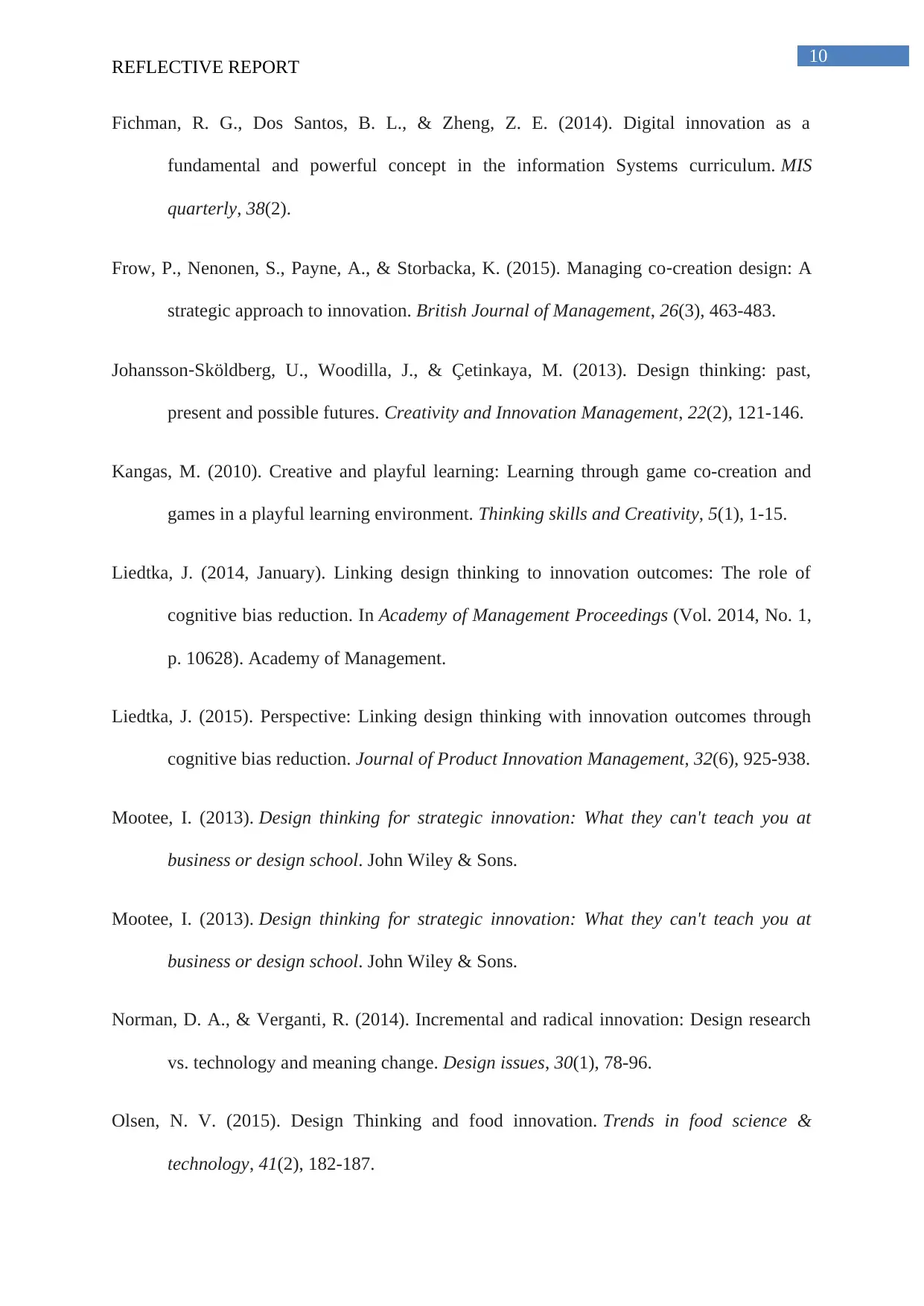
10
REFLECTIVE REPORT
Fichman, R. G., Dos Santos, B. L., & Zheng, Z. E. (2014). Digital innovation as a
fundamental and powerful concept in the information Systems curriculum. MIS
quarterly, 38(2).
Frow, P., Nenonen, S., Payne, A., & Storbacka, K. (2015). Managing co‐creation design: A
strategic approach to innovation. British Journal of Management, 26(3), 463-483.
Johansson‐Sköldberg, U., Woodilla, J., & Çetinkaya, M. (2013). Design thinking: past,
present and possible futures. Creativity and Innovation Management, 22(2), 121-146.
Kangas, M. (2010). Creative and playful learning: Learning through game co-creation and
games in a playful learning environment. Thinking skills and Creativity, 5(1), 1-15.
Liedtka, J. (2014, January). Linking design thinking to innovation outcomes: The role of
cognitive bias reduction. In Academy of Management Proceedings (Vol. 2014, No. 1,
p. 10628). Academy of Management.
Liedtka, J. (2015). Perspective: Linking design thinking with innovation outcomes through
cognitive bias reduction. Journal of Product Innovation Management, 32(6), 925-938.
Mootee, I. (2013). Design thinking for strategic innovation: What they can't teach you at
business or design school. John Wiley & Sons.
Mootee, I. (2013). Design thinking for strategic innovation: What they can't teach you at
business or design school. John Wiley & Sons.
Norman, D. A., & Verganti, R. (2014). Incremental and radical innovation: Design research
vs. technology and meaning change. Design issues, 30(1), 78-96.
Olsen, N. V. (2015). Design Thinking and food innovation. Trends in food science &
technology, 41(2), 182-187.
REFLECTIVE REPORT
Fichman, R. G., Dos Santos, B. L., & Zheng, Z. E. (2014). Digital innovation as a
fundamental and powerful concept in the information Systems curriculum. MIS
quarterly, 38(2).
Frow, P., Nenonen, S., Payne, A., & Storbacka, K. (2015). Managing co‐creation design: A
strategic approach to innovation. British Journal of Management, 26(3), 463-483.
Johansson‐Sköldberg, U., Woodilla, J., & Çetinkaya, M. (2013). Design thinking: past,
present and possible futures. Creativity and Innovation Management, 22(2), 121-146.
Kangas, M. (2010). Creative and playful learning: Learning through game co-creation and
games in a playful learning environment. Thinking skills and Creativity, 5(1), 1-15.
Liedtka, J. (2014, January). Linking design thinking to innovation outcomes: The role of
cognitive bias reduction. In Academy of Management Proceedings (Vol. 2014, No. 1,
p. 10628). Academy of Management.
Liedtka, J. (2015). Perspective: Linking design thinking with innovation outcomes through
cognitive bias reduction. Journal of Product Innovation Management, 32(6), 925-938.
Mootee, I. (2013). Design thinking for strategic innovation: What they can't teach you at
business or design school. John Wiley & Sons.
Mootee, I. (2013). Design thinking for strategic innovation: What they can't teach you at
business or design school. John Wiley & Sons.
Norman, D. A., & Verganti, R. (2014). Incremental and radical innovation: Design research
vs. technology and meaning change. Design issues, 30(1), 78-96.
Olsen, N. V. (2015). Design Thinking and food innovation. Trends in food science &
technology, 41(2), 182-187.
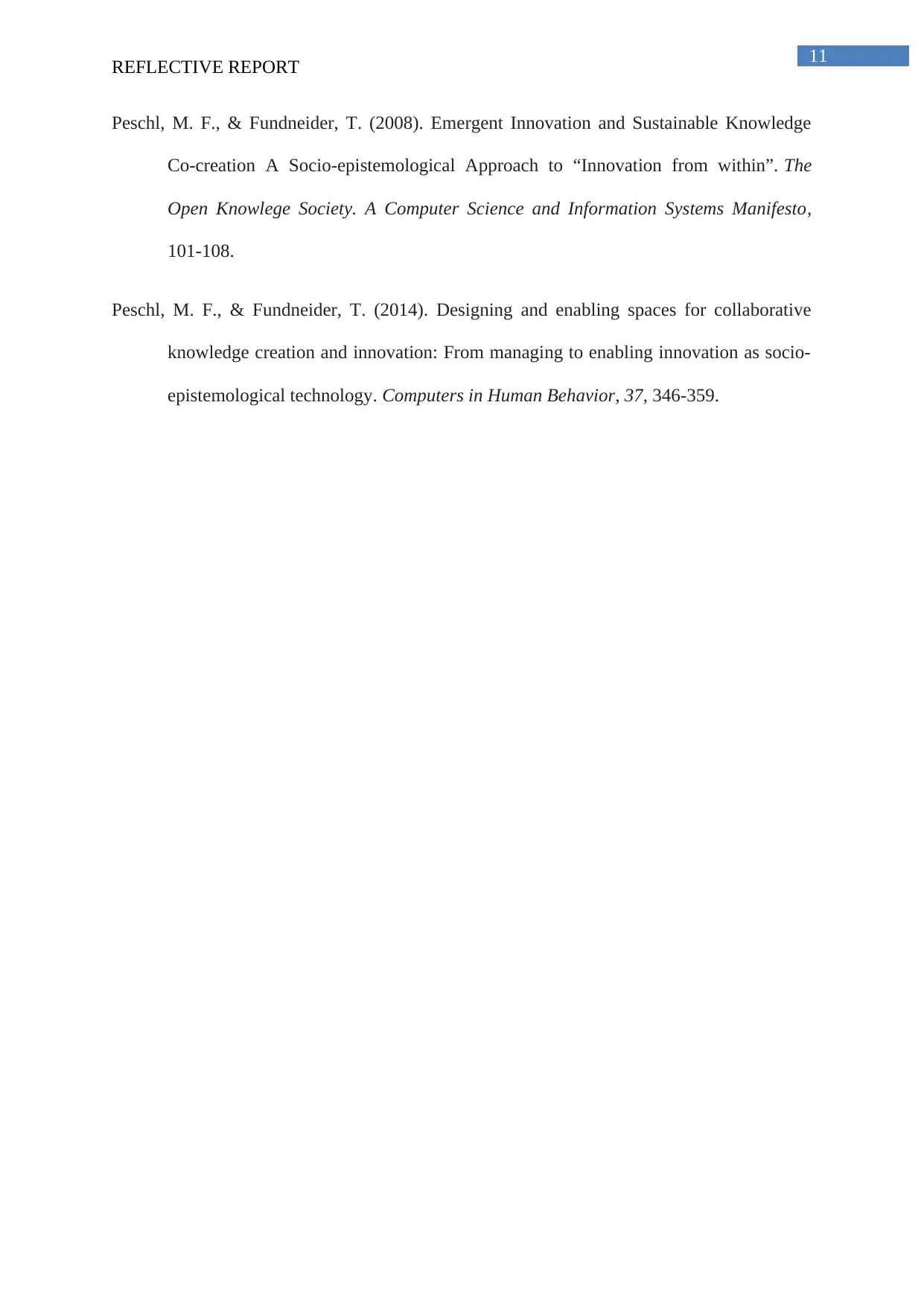
11
REFLECTIVE REPORT
Peschl, M. F., & Fundneider, T. (2008). Emergent Innovation and Sustainable Knowledge
Co-creation A Socio-epistemological Approach to “Innovation from within”. The
Open Knowlege Society. A Computer Science and Information Systems Manifesto,
101-108.
Peschl, M. F., & Fundneider, T. (2014). Designing and enabling spaces for collaborative
knowledge creation and innovation: From managing to enabling innovation as socio-
epistemological technology. Computers in Human Behavior, 37, 346-359.
REFLECTIVE REPORT
Peschl, M. F., & Fundneider, T. (2008). Emergent Innovation and Sustainable Knowledge
Co-creation A Socio-epistemological Approach to “Innovation from within”. The
Open Knowlege Society. A Computer Science and Information Systems Manifesto,
101-108.
Peschl, M. F., & Fundneider, T. (2014). Designing and enabling spaces for collaborative
knowledge creation and innovation: From managing to enabling innovation as socio-
epistemological technology. Computers in Human Behavior, 37, 346-359.
1 out of 12
Related Documents
Your All-in-One AI-Powered Toolkit for Academic Success.
+13062052269
info@desklib.com
Available 24*7 on WhatsApp / Email
![[object Object]](/_next/static/media/star-bottom.7253800d.svg)
Unlock your academic potential
© 2024 | Zucol Services PVT LTD | All rights reserved.





